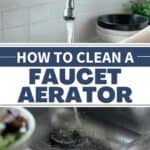This post may contain affiliate links. If you use these links to buy something we may earn a small commission. Thanks.
You might be looking at your corroded faucet, thinking the time has come to replace it. But with a number of great ways to clean your faucet, it might not be time to throw in the towel yet.
If you’re wondering how to clean a corroded faucet, you’re in the right place.
We’re going to show you the 7 most effective ways to clean corroded faucets in easy-to-follow, step-by-step guides.
What Causes Faucet Corrosion?
Because your faucets come into contact with moisture almost every day, the chemical reaction caused by this and the air can lead to it becoming rusted over time. Faucets are also susceptible to mineral deposits building up over time.
Both of these can look unsightly but also cause more significant problems. Corroded faucets can seize, and the build-up within the faucet can lead to blockages or poor water pressure.
Knowing how to clean a corroded faucet can help to save you the time and expense of having to replace them and, in most cases, is relatively straightforward.
Many of these tactics are great for cleaning calcium buildup on faucets as well!
How To Clean a Corroded Faucet
Suppose you have corroded kitchen or bathroom faucets. In that case, you may be able to use one of the following methods to remove the corrosion, rust, or mineral deposits so that the faucet looks good and its performance is greatly improved.
You must be in a well-ventilated area, wear rubber gloves, safety goggles, and a ventilation mask when appropriate. Some of the chemicals below can irritate the skin and produce fumes you should avoid breathing in.
These methods are not only great for dealing with faucets that have a corroded surface, and their performance is suffering because of it, but they can also be used as a preventative method – try adding them to your regular faucet cleaning process.
Cleaning Method 1: White Vinegar
- The first option for cleaning your faucet using white vinegar is to remove the faucet and dismantle it. Then soak the parts for around ten minutes. It is important to remember the steps you took to dismantle it for putting it back together.
- To get rid of as much corrosion as possible, you’ll want to dismantle the faucet down into its constituent faucet parts.
- Next, take an old toothbrush and scrub the parts to remove the corrosion.
- After scrubbing, you should rinse the parts thoroughly to remove all traces of corrosion, dirt, or mineral deposit build-ups. Ensure you have covered the sinkhole so smaller parts are not lost.
- Finally, take a clean cloth, a towel, or a paper towel and dry the parts before reassembling.
If you cannot dismantle the faucet due to corrosion, follow the next steps to clean the faucet using white vinegar.
- Pour your white vinegar solution into a plastic bag and hold it at an angle so the vinegar goes to the bottom corner.
- You can now fit this over the faucet, fully submerging it. Tie it in place using rubber bands and allow it to soak for 24 hours.
- After the 24 hours have passed, you should remove the bag and vinegar, which can now be disposed of.
- Use an old toothbrush to scrub the faucet. The corroded areas should have begun dissolving in the vinegar, making it easier to remove.
- After doing this, use a towel, clean cloth, or paper towel to rinse the faucet down and clean off the corrosion.
- After the faucet has been thoroughly cleaned off, use a dry cloth or towel to dry it.
This is our favorite way to clean a corroded faucet because it’s all natural.
Cleaning Method 2: Oxalic Acid
Always follow our safety advice when cleaning with any chemicals or solutions. Wear protective clothing – rubber gloves, eye protection, and a ventilation mask are advised. It would be best if you always worked in a well-ventilated area too.
- Create a solution of Oxalic Acid (25ml) and water (250ml) and pour it onto the corroded areas of the faucet. Leave this to soak for 30 minutes.
- After 30 minutes, thoroughly wash the faucet and rinse it clean of any residue.
- Finally, you need to use a dry cloth to dry the area thoroughly.
Cleaning Method 3: WD-40
Most toolboxes will have a can of WD-40, and this versatile option can surprisingly come in handy for cleaning corroded faucets.
- Wipe down the faucet with a cloth to remove any loose dirt.
- Spray your faucet all over with the WD-40. Cover up the areas around to avoid getting sprayed.
- Use a clean wire brush to scrub the faucet and remove the corrosion.
- After the faucet has been thoroughly scrubbed, rinse it with cold water and wipe clean.
- You will now be able to dry off the faucet using a clean, dry towel or cloth.
Cleaning Method 4: Citric Acid
Citric acid is an excellent cleaner and can easily be found in most shops. Rubber gloves are essential for this method, as are the other safety measures outlined previously.
- Your first step for cleaning a corroded faucet using citric acid is creating a solution in a plastic container using the acid and a little water. You can then apply this to the rusty faucet.
- After 45 minutes, you should scrub the faucet before rinsing the residue and dirt using clean warm water.
- Use a dry cloth or towel to dry off the faucet for an excellent finish.
Cleaning Method 5: Lemon Juice Paste
You will need salt and a lemon or lemon juice for this excellent method that makes the most of the acidic qualities the lemon has to offer and the rough, grainy texture of the salt.
- First, you should clean off the faucet to remove any loose dirt or grime. You can then sprinkle salt over the area and squeeze lemon juice over the top of this.
- You should leave this paste you have just created for around 3 hours before using a soft brush or toothbrush to wipe the paste off gently.
- You can repeat this process several times until you get the desired result.
- Wipe the faucet clean using a dry, clean cloth when you are finished with the process.
Cleaning Method 6: Baking Soda
Like lemon juice and vinegar, baking soda is another regular household item that is great for cleaning.
- Use warm water and baking soda to make a paste that can be applied to the corroded faucet.
- After 10 minutes, scrub the area with an old toothbrush until the dirt is removed.
- After the faucets have been thoroughly brushed clean, rinse with clean water.
- Use a clean cloth or towel to dry your faucets after they have been cleaned and rinsed.
Cleaning Method 7: Aluminum Foil
The last method is another excellent option that uses everyday household items to remove corrosion from your faucets. All you have to do is scrunch the aluminum foil into a ball and dip it in water before gently scrubbing the faucet.
It couldn’t be simpler, and the chemical reaction created between the corrosion’s components and aluminum works to remove it from the faucet.
Final Thoughts
It goes without saying that not all faucets can be saved. If the corrosion has continued for a considerable period of time, it could be too late to save it, and you might be better off buying a replacement.
Usually, using one, or a combination, of the methods above can save a faucet and bring it back to excellent working order and looking like new. These methods are extremely cost-effective and do not take much time, so they are always worth trying.
We hope you can use some of these methods to clean a rusty faucet surface and enjoy great-looking kitchen and bathroom fixtures and better performance.


